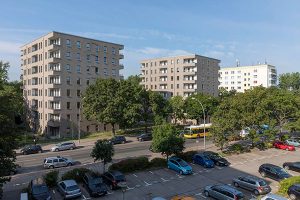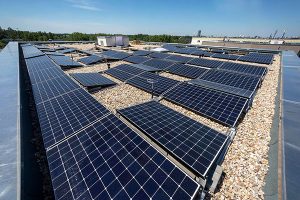 HOWOGE built a CO2-neutral dwelling with 99 apartments in Berlin-Lichtenberg. On an approximately 5,400-square-meter site on Sewanstrasse in Lichtenberg, HOWOGE has built a neighborhood that already exceeds the German government’s climate protection targets while also providing social housing; 50% of the apartments are subsidized. Thanks to an energy-optimized construction method and the use of innovative building technology, the two eight-story buildings were also able to be realized as climate-neutral energy-positive dwelling. In addition, the tenants of the 99 apartments have the opportunity to simultaneously obtain environmentally friendly and inexpensive electricity.
HOWOGE built a CO2-neutral dwelling with 99 apartments in Berlin-Lichtenberg. On an approximately 5,400-square-meter site on Sewanstrasse in Lichtenberg, HOWOGE has built a neighborhood that already exceeds the German government’s climate protection targets while also providing social housing; 50% of the apartments are subsidized. Thanks to an energy-optimized construction method and the use of innovative building technology, the two eight-story buildings were also able to be realized as climate-neutral energy-positive dwelling. In addition, the tenants of the 99 apartments have the opportunity to simultaneously obtain environmentally friendly and inexpensive electricity.
In addition to the energy-optimized construction of buildings (facade insulation and other heat-transferring surfaces such as windows, doors and ceilings), energy technology plays a key role in the construction of climate-neutral properties. “Climate neutrality means that a building only emits as much CO2 as nature can break down again,” explains Kay Gröne, energy manager at HOWOGE Wärme GmbH. “This figure is defined for buildings as 7 kilograms of CO2 per square meter per year. Here in Sewanstrasse, we were even able to achieve a negative CO2 balance with a value of minus 4 kilograms.” This is made possible by a holistic energy concept that combines decentralized drinking water stations with low system temperatures, controlled living space ventilation with heat recovery, a photovoltaic system with battery storage and green tenant electricity
Facts and Data
- Winner of the Federal ENVIRONMENT & BUILDING Award 2020, Residential Building Category
- The decentralized drinking water stations for water heating are particularly innovative. The CO2 savings here result primarily from low system temperatures. “Conventional systems heat the water centrally to 60 degrees and distribute this throughout the house. Due to the high temperatures and long distances, this leads to enormous heat losses,” knows Burghard Fleischhauer, who is responsible for the technical building equipment of the new buildings at HOWOGE. “Our drinking water stations only heat the water to 45 degrees, and only when the tap is turned on. This results in energy savings of up to 30 percent.”
- Another advantage is that the system requires less piping. Internal calculations have shown that in a project with around 600 apartments, this fact alone can create about an additional 120 square meters usable space, e.g. for living areas, stroller and walker rooms or bicycle parking.
- In addition to the drinking water station, each apartment has a living space ventilation system with heat recovery. This principle works by directing the stale, warm air to the outside and drawing in cold air at the same time. In this way, the heat from the stale exhaust air is used to bring the fresh and cold outside air to comfortable temperatures without any heating at all. In this way, a heat recovery rate of up to 82% can be achieved.
- The concept is rounded off by the photovoltaic system with 402 modules on the roof and the battery storage on the first floor. The photovoltaic system has an output of 145 kWpeak and is operated by HOWOGE Wärme, which offers the electricity as low-cost, CO2-free tenant electricity from its own roof. Electricity prices are around 3 cents per kilowatt hour below comparable market rates, making a noticeable contribution to a favorable overall rent.
- “Initially, we expect warm operating costs of 80 cents and are already 10 cents below the Berlin average,” says Kay Gröne.





